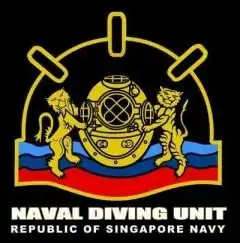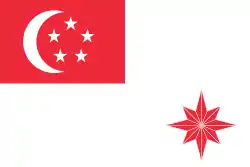Naval Diving Unit (Singapore)
The Naval Diving Unit (NDU) (Chinese: 海军潜水特种部队) is the maritime special forces unit of the Republic of Singapore Navy, and is a component of the Special Operations Task Force of the Singapore Armed Forces. The unit is regularly tasked with salvage operations, underwater ordnance disposal, marine commando, and frogman warfare. It serves as the naval counterpart to the Singapore Armed Forces Commando Formation.
| Naval Diving Unit | |
|---|---|
 Logo of Naval Diving Unit | |
| Active | 1971 – Present |
| Country | |
| Branch | Special Operations Task Force |
| Type | Special forces |
| Role | Special operations Counter-terrorism Special reconnaissance |
| Size | Classified |
| Garrison/HQ | Sembawang Camp[1] |
| Nickname(s) | Elite Frogmen The A-Team Warriors of the Deep |
| Motto(s) | Nothing Stands In Our Way |
| Engagements | 2004 Indian Ocean earthquake and tsunami Iraq war War in Afghanistan Reconstruction of Iraq Counter-piracy in the Gulf of Aden International military intervention against ISIL |
| Commanders | |
| Current commander | Colonel Chew Kuok Hsin |
The unit is trained in airborne, underwater, and land warfare capabilities, making it a unit capable of direct action and covert missions within hostile territory, as well as maritime hostage rescue operations. The size of the unit and the details of their missions are kept classified due to their sensitive nature. It is often described as Singapore's equivalent to the Navy SEALs of the United States Navy and the Special Boat Service of the Royal Navy.
History
In 1959, the British Far East Fleet Clearance Diving Team (FECDT) established a base of operations at HMS Terror Camp, which is the current headquarters of the unit.[2] When the Royal Navy left Singapore on 12 December 1971, the FECDT was replaced by the Singapore Armed Forces Diving Centre under the command of Major Robert Khoo. The unit was made up of a group of divers recruited from the ranks of the Singapore Maritime Command, which is now the Republic of Singapore Navy. The divers were trained by Lieutenant Victor Rodrigues and were tasked with the maintenance of the Command's naval assets.
In 1975, the SAF Diving Centre became officially known as the Naval Diving Unit, and its current roles were reassigned in 1985 when it was perceived that underwater explosive ordnance disposal capabilities and the security of Singapore's waterways were becoming increasingly crucial in Singapore's maritime trade dependence. The Navy's fleet had also grown significantly by then, and more divers were needed to support the vessels at bay and on overseas deployments. Naval divers were involved in the salvage operations following the 1997 crash of SilkAir Flight MI185.[3]
The NDU of the 1990s is almost totally unrecognisable from its forebear, the SAF Diving Centre of 1972. Traces of its legacy, however, exist at the Singapore Naval Medical and Hyperbaric Center. in the form of the British made Camel Laird 10-man hyperbaric chamber.
Organisation and training
| Republic of Singapore Navy |
|---|
 |
| Formations |
| Ships |
| List of ships of the Republic of Singapore Navy |
| Bases |
Selection
In NDU, Full-time National Servicemen (NSF) and regulars are expected to undergo the same training before they are qualified to become part of the unit. Recruitment begins with a vocational assessment, whereby NSFs are selected among the thousands that enlist each year. During the primary stage of selection, physical fitness results and medical records are evaluated. Thereafter, an aptitude test is conducted by Applied Behavioural Sciences Department (ABSD) to gauge the recruit. Medical fitness criteria such as perfect eyesight and the absence of chronic illnesses that may impede their training will have to be met before potential entrants undergo a battery of further tests that include a water confidence and hyperbaric chamber test, as well as another round of psychological evaluation. Those who meet all the requirements will then be enlisted into the unit.
Frogman School
Recruits undergo a nine-month training at the Frogman School to become part of the Naval Diving Unit. The training comprises the three-month Basic Military Training and nine-month Combat Diver Course. For Basic Military Training, recruits will experience a largely similar training programme as National Servicemen from other combat vocations, albeit at Sembawang Camp instead of the Basic Military Training Centre.
In the Combat Diver Course, recruits learn relevant skills such as drown-proofing and scuba diving, while developing their physical fitness in preparation for a fitness assessment, all of which take place in four phases (Physical Phase, Diving Phase, Land Combat Training, and Shipboard Competency). Passing requirements in the fitness assessment include a sub-20 minute timing for the sea circuit course, sub-29 minute timing for a 6 kilometre run, sub-58 minute timing for a 2 kilometre sea swim with diving equipment, and the attainment of the Diver Gold Award for the Individual Physical Proficiency Test (IPPT). Additionally, recruits must score 80% or higher in a diving theory assessment. These prerequisites qualify recruits for the Team Building Week, commonly known as Hell Week,[4] which is a five-day intensive phase which institutes stress exposure training by combining sleep deprivation and physical exertion, and serves as the final component of the course.
By this stage, as many as 60% of recruits would have dropped out. Those who drop out are transferred to other service units, while those who graduate will pass out and be formally known as frogmen, and are assigned to either the Underwater Demolition Group, Clearance Diving Group, or Special Warfare Group.
Underwater Demolition Group
The Underwater Demolition Group is where most National Service trainees are assigned to, and specialises in the demolition of natural maritime barriers, as well as sabotage operations on enemy maritime infrastructure.
Clearance Diving Group
The Clearance Diving Group is another group within the unit tasked with help preserving the safety of Singapore's vital sea lanes, and specialises in improvised explosive device disruption, underwater mine disposal, and bomb disposal. The group works alongside mine countermeasures vessels and is an integral part of the Naval Explosive Ordnance Disposal Unit.
The group is also a component of the Accompanying Sea Security Teams (ASSeT), and carries out visit, board, search, and seizure operations on ships that carry highly sensitive or potentially hazardous articles through Singaporean waters.
Special Warfare Group
The Naval Diving Unit's Special Warfare Group is an all-regular unit created as a counterpart to the Army Commando's Special Operations Force starting off under the name "The A-Team" in 1987, and specialises in conducting special operations over land, air and sea. The group has access to the latest equipment, and is tasked with airborne, reconnaissance, and direct action operations. The best performing candidates from Special Forces Qualification Course are selected to attend the Special Warfare Course before being inducted into this group. Naval divers from this group are also regularly sent overseas for training, and may also be invited to attend the United States Navy's Basic Underwater Demolition/SEAL (BUD/S) course. In 2001, Captain Wong Foo Chan, who was from the Special Warfare Group, became the first foreigner to top his class in the Green Berets course, and received a commendation medal for this achievement.
The group's insignia of the shows an anchor, re-breather and trident over a pair of bat wings, with the motto: "Will to Do, Spirit to Dare".
Career Paths
After the Combat Diver Course is over, naval divers may split two possible career paths, which are the Specialist Career Path and the Officer Career Path.
In the Specialist Career Path, trainees will go through Combat Advanced Skills Training for a month, training in basic land combat. They will then be in the Special Forces Qualification Course for 9 months to be trained in combat diving, free-fall, and advanced demolitions, to deal with the full spectrum of special operations. The final course will be the four-month Special Warfare Course, where trainees will learn skills to be a part of the Special Warfare Group.
In the Officer Career Path, trainees will be trained in leadership and mission planning. The trainees will be trained at the Officer Cadet School for nine months. The trainees will get to train on board one of the RSN's vessels. After which, they will go through the Naval Diver Professional Phase.
Equipment
| Pistols | ||||
|---|---|---|---|---|
| Model | Origin | Caliber | Version | Notes |
| SIG Sauer P226 | 9×19mm Parabellum | P226 E2 | ||
| Glock 17 | 9×19mm Parabellum | Glock 17 Gen 3 | ||
| FN Five-seven | FN 5.7×28mm | Mark 1 | ||
| Sub-machine guns | ||||
| H&K MP7 | HK 4.6×30mm | MP7A1 | ||
| H&K MP5 | 9×19mm Parabellum | MP5A3
MP5SD3 MP5K-N MP5K-PDW |
||
| FN P90 | FN 5.7×28mm | P90 TR | ||
| Assault rifles | ||||
| H&K HK416 | 5.56×45mm NATO | D10RS
D14.5RS |
||
| M4 carbine | 5.56×45mm NATO | M4A1 SOPMOD Block 1 | ||
| CAR-15 | 5.56×45mm NATO | Colt Model 653
Colt Model 723 |
||
| SAR-21 | 5.56×45mm NATO | SAR21, SAR21 MMS | ||
| Sniper rifles | ||||
| M110 SASS | 7.62×51mm NATO | |||
| Sako TRG-22 | ||||
| Accuracy International AX50 | ||||
| Machine guns | ||||
| Ultimax 100 | 5.56×45mm NATO | Mark 3 | ||
| FN MAG | 7.62×51mm NATO | |||
| STK 50MG | 12.7×99mm NATO | |||
| Grenade launchers | ||||
| M320 GLM | 40 mm grenade | |||
| M203 | 40 mm grenade | |||
| Milkor MGL | 40 mm grenade | |||
| STK 40AGL | 40 mm grenade | |||
In popular culture
The unit was the subject of the 2015 Jack Neo film Ah Boys to Men 3: Frogmen.[5] Prior to the film's release, there was little public awareness about the unit. It was filmed on location at the NDU headquarters in Sembawang Camp and some of the trainees and instructors participated in minor roles and as technical consultants.[6][7]
See also
References
- "9 things ABTM3 didn't tell you about Sembawang Camp". Ministry of Defence (Singapore). 30 December 2015. Archived from the original on 20 June 2019. Retrieved 20 June 2019.
- migration (27 July 2014). "Singapore's naval divers special: Proving their mettle". The Straits Times. Archived from the original on 22 July 2019. Retrieved 17 November 2019.
- Chern, Alphonsus (27 July 2014). "Singapore's naval divers special: Proving their mettle". The Straits Times. Archived from the original on 22 July 2019. Retrieved 22 July 2019.
- Chern, Alphonsus (30 July 2014). "Through hell and back to become navy's masters of the deep". AsiaOne. Archived from the original on 20 June 2019. Retrieved 20 June 2019.
- Teo Jing Ting (18 February 2015). "From boys to naval divers". Pioneer. Ministry of Defence (Singapore). Archived from the original on 20 June 2019. Retrieved 20 June 2019.
- "Setting the scene". AsiaOne. 9 July 2015. Archived from the original on 20 June 2019. Retrieved 20 June 2019.
- "Post dated 17 February 2015". Republic of Singapore Navy Official Facebook Page.
External links
| Wikimedia Commons has media related to Naval Diving Unit (Singapore). |